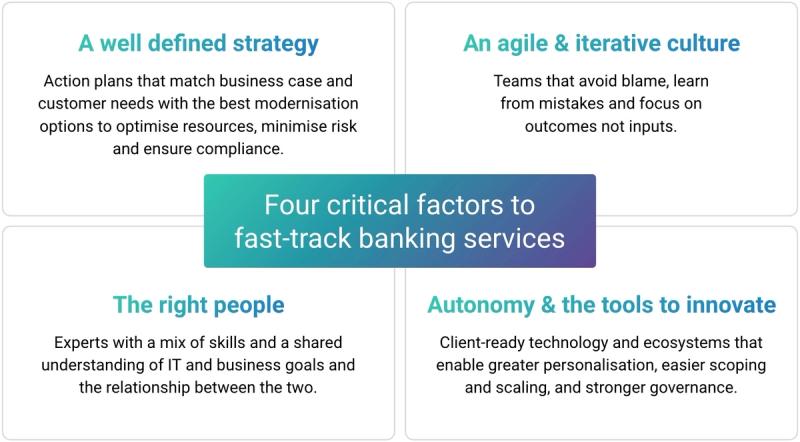With a global emphasis on financial inclusion, we can expect over 500 million new banking users by 2025. Growing these customers from low-value transaction-based services to higher-value financial offerings, could potentially unlock $75 billion worth of growth annually.
Yet despite the multi-billion dollar opportunity, incumbent banks are still struggling to grow. In fact, over two thirds (67%) of banks surveyed think that, without transformation, they will lose market share within two years. So what’s holding them back?
Long development cycles and increasing competition from new entrants mean many incumbent banks are missing out simply because they are too slow to develop and launch personalised offerings. This leaves competitors free to scoop up underserved customers and grow them to higher-revenue services.
To seize future growth opportunities, incumbent banks will have to speed up their ability to expand their product set beyond one-size-fits-all offerings.
As demand for higher-margin wealth, investment and lending services rise, banks must strive to be more adaptive, responsive and customer-centric than ever.
In recent years, we have seen accelerating growth from fintechs with four of the nine most valuable unicorns being fintech firms. In addition, younger demographics are more tech-inclined being 2.7 times more likely to be a mobile-first banker compared to older generations. This, combined with three years of muted banking revenue growth, means banks are under increasing pressure to find and nurture new business.
Incumbent banks often lack the agile infrastructure to perform quick product launches and rapid iterations based on customer and market feedback.
Historically, incumbent banks have been unable to adopt new technology and launch new offerings as readily as fintechs and neobanks that leverage digital and cloud capabilities to operate cheaper, simpler and faster. Take, for instance, Klarna which introduced buy now, pay later (BNPL) in the UK in 2014 while incumbent banks have only recently begun showing interest in the space. Take, for instance, ZestMoney which introduced its equated monthly installments (EMI) offering in India in 2015 while incumbent banks have only recently begun showing interest in buy now, pay later (BNPL).
Too often, incumbents are being constrained by monolithic architectures which have haphazardly grown over time. This leads to multiple interdependencies and bottlenecks. This is exacerbated by poorly documented legacy code that creates over-reliance on a limited number of experts and drains efficiency through cumbersome manual delivery processes.
At the same time, the historic trend of bank consolidation with over 2300 bank mergers in the United States in the past decade means more systems and complexity. This increases the effort required to manage and maintain systems, ultimately leading to longer product development cycles.
Accelerated time to market is a core competitive advantage in continuously evolving financial ecosystems.
A McKinsey & Company study found that a product which is late to market by six months earns 33% lower profits over a five year period but if a product is launched on time even if 50% over-budget, profits only decrease by 3.5%
Cloud-native technology providing flexibility and agility is now critical to compete in the customer segments of tomorrow. As cloud investment and capabilities increase, time to launch new products in the market has reduced.
This is especially true when innovation is sourced through APIs and composable banking, as with Mambu’s platform. Here, banks can connect to ecosystems for new product offerings; automate testing for shorter time-frames and increased reliability; and reconfigure and repurpose functionality on demand to meet changing customer needs.
Mambu customers typically experience a 60-80% reduction in time to market and can launch MVPs in weeks and full digital banks in under six months. New use cases, customer experiences and business models can be delivered via a more cost-effective and low-code approach that reduces reliance on specific skill sets and allows services to scale fast.
However, service innovation is not just about digital transformation and technology.
Being ready to respond rapidly to new market drivers and customer expectations may require a shift in strategy. For instance, shifting the product design emphasis away from banking products towards addressing customer needs. To do this, conversations around innovation will have to shift from “What can we achieve with the technology we have?” to “What is it that our customers really want and how can we deliver it faster, easier and at lower cost?”. For example, one of Mambu’s customers, Amsterdam Trade Bank, pivoted to launch a new offering under a new brand, FIBR, that would offer digital-native lending to SMEs with a simple, quick and transparent value proposition.
It involves a cultural willingness to be truly agile and iterative, the desire to work collaboratively with partners and ecosystems, and the vision and execution to align enterprise resources so they can move at pace.
Above all, it means allowing development teams to explore, discover and succeed without fear of failure or blame.
At Mambu we believe there are four critical success factors to turbo-boost hyper-targeted banking services:

To win a bigger slice of the market, incumbent banks must be able to act now to exploit growth opportunities as they arise.
For banks that are still hungry for growth, speed of innovation is now as important as direction.
With so much to play for, finding partners, platforms and people to help shrink development time frames and scale-up fast is mission critical.
For more insight on time to market and the digital service opportunity download our latest infographic:
